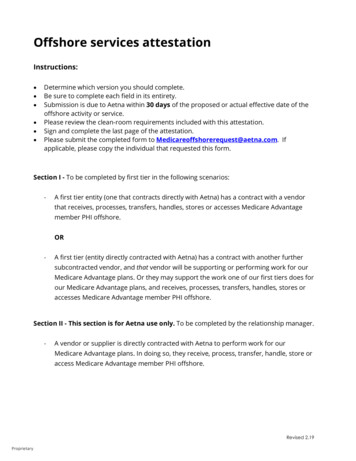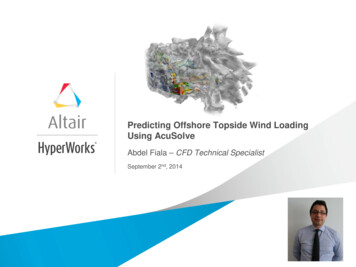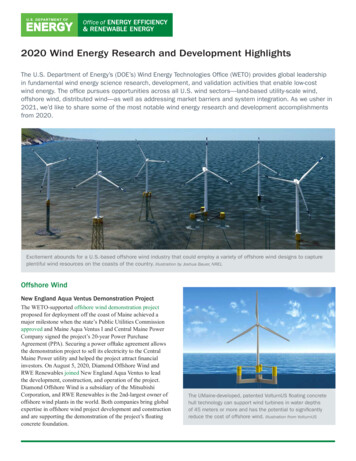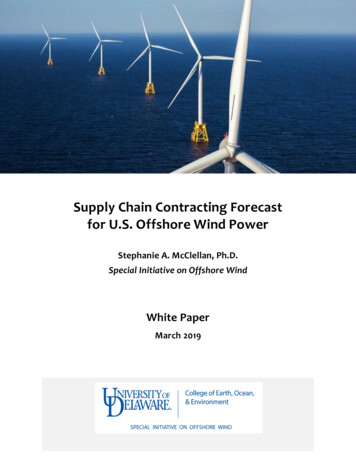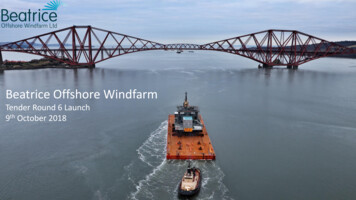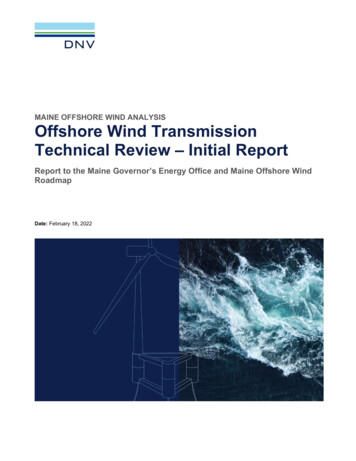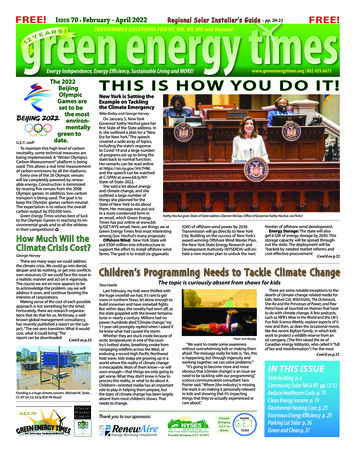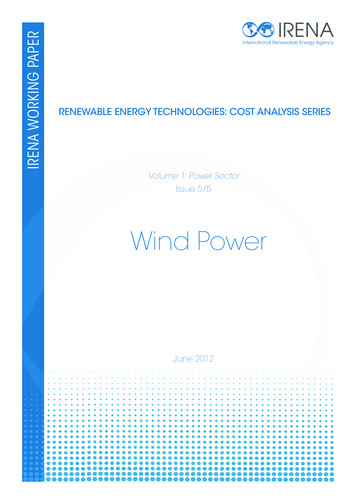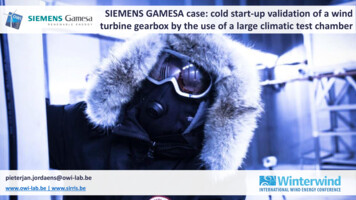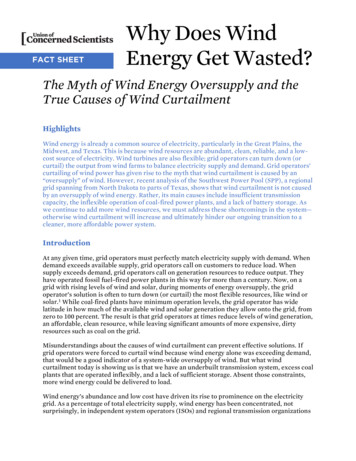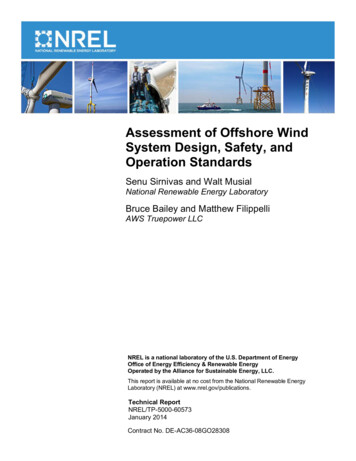
Transcription
Assessment of Offshore WindSystem Design, Safety, andOperation StandardsSenu Sirnivas and Walt MusialNational Renewable Energy LaboratoryBruce Bailey and Matthew FilippelliAWS Truepower LLCNREL is a national laboratory of the U.S. Department of EnergyOffice of Energy Efficiency & Renewable EnergyOperated by the Alliance for Sustainable Energy, LLC.This report is available at no cost from the National Renewable EnergyLaboratory (NREL) at www.nrel.gov/publications.Technical ReportNREL/TP-5000-60573January 2014Contract No. DE-AC36-08GO28308
Assessment of Offshore WindSystem Design, Safety, andOperation StandardsSenu Sirnivas and Walt MusialNational Renewable Energy LaboratoryBruce Bailey and Matthew FilippelliAWS Truepower LLCPrepared under Task No. WE11.5057NREL is a national laboratory of the U.S. Department of EnergyOffice of Energy Efficiency & Renewable EnergyOperated by the Alliance for Sustainable Energy, LLC.This report is available at no cost from the National Renewable EnergyLaboratory (NREL) at www.nrel.gov/publications.National Renewable Energy Laboratory15013 Denver West ParkwayGolden, CO 80401303-275-3000 www.nrel.govTechnical ReportNREL/TP-5000-60573January 2014Contract No. DE-AC36-08GO28308
NOTICEThis report was prepared as an account of work sponsored by an agency of the United States government.Neither the United States government nor any agency thereof, nor any of their employees, makes any warranty,express or implied, or assumes any legal liability or responsibility for the accuracy, completeness, or usefulness ofany information, apparatus, product, or process disclosed, or represents that its use would not infringe privatelyowned rights. Reference herein to any specific commercial product, process, or service by trade name,trademark, manufacturer, or otherwise does not necessarily constitute or imply its endorsement, recommendation,or favoring by the United States government or any agency thereof. The views and opinions of authorsexpressed herein do not necessarily state or reflect those of the United States government or any agency thereof.This report is available at no cost from the National Renewable Energy Laboratory (NREL)at www.nrel.gov/publications.Available electronically at http://www.osti.gov/bridgeAvailable for a processing fee to U.S. Department of Energyand its contractors, in paper, from:U.S. Department of EnergyOffice of Scientific and Technical InformationP.O. Box 62Oak Ridge, TN 37831-0062phone: 865.576.8401fax: 865.576.5728email: mailto:reports@adonis.osti.govAvailable for sale to the public, in paper, from:U.S. Department of CommerceNational Technical Information Service5285 Port Royal RoadSpringfield, VA 22161phone: 800.553.6847fax: 703.605.6900email: orders@ntis.fedworld.govonline ordering: http://www.ntis.gov/help/ordermethods.aspxCover Photos: (left to right) photo by Pat Corkery, NREL 16416, photo from SunEdison, NREL 17423, photo by Pat Corkery, NREL16560, photo by Dennis Schroeder, NREL 17613, photo by Dean Armstrong, NREL 17436, photo by Pat Corkery, NREL 17721.Printed on paper containing at least 50% wastepaper, including 10% post consumer waste.
AcknowledgmentsThe National Renewable Energy Laboratory (NREL) and AWS Truepower LLC would like toacknowledge the support and cooperation of the U.S. Department of Energy (DOE) in fundingthe associated research program (Contract No. DE-EE0005372) and reviewing this report.Additionally, the authors would like to thank Sheri Anstedt (NREL), Matt Baker (AWSTruepower), Joel Cline (DOE), Fort Felker (NREL), Rudy Hall (Keystone Engineering), andCharlotte Bay Hasager (Technical University of Denmark) for their cooperative assistance inreviewing and commenting on this report.iThis report is available at no cost from the National Renewable Energy Laboratory (NREL) at www.nrel.gov/publications.
AcronymsABSAmerican Bureau of ShippingAPIAmerican Petroleum InstituteAWEAAmerican Wind Energy AssociationBOEMBureau of Ocean Energy ManagementBOEMREBureau of Ocean Energy Management, Regulation, and EnforcementBSEEBureau of Safety and Environmental EnforcementBSHFederal Maritime and Hydrographic Agency (Bundesamt fürSeeschifffahrt und Hydrographie)BVBureau VeritasCFRCode of Federal RegulationsCoVCoefficient of VariationCVACertified Verification AgentDLCDesign Load CaseDNVDet Norske VeritasDOEU.S. Department of EnergyDOIU.S. Department of InteriorGLGermanischer LloydGOMGulf of MexicoIECInternational Electrotechnical CommissionISOInternational Organization for StandardsLRFDLoad Resistance Factor DesignMMSMinerals Management ServiceNASNational Academy of ScienceOCRPOffshore Compliance Recommended PracticesOCSOuter Continental ShelfUSACEU.S. Army Corps of EngineersWSDWorking Stress DesigniiThis report is available at no cost from the National Renewable Energy Laboratory (NREL) at www.nrel.gov/publications.
Table of ContentsAcknowledgments. iAcronyms . iiList of Figures . iiiList of Tables . iv1 Introduction . 11.1 Scope. 21.2 Background . 51.3 Met-Ocean Data . 72 Regulations, Standards, Guidelines, and Certification . 102.1 Regulations . 102.2 Standards. 132.3 Guidelines . 162.4 Certification . 183 Challenges in Adapting European Procedures . 234 Tropical Cyclone and Hurricane Provisions. 254.1 International Electrotechnical Commission . 284.2 Det Norske Veritas. 294.3 Germanischer Lloyd. 294.4 American Bureau of Shipping . 305 Bureau of Ocean Energy Management and Bureau of Safety and Environmental EnforcementActivities . 315.1 Cape Wind . 315.2 American Bureau of Shipping Technology Assessment and Research . 316 Conclusion . 337 Recommendations . 34References . 36Appendix A: Regulations . 39Appendix B: Standards . 40Appendix C: Guidelines . 43Appendix D: International Electrotechnical Commission/American Bureau of Shipping Design LoadCases. 49List of FiguresFigure 1. Standards and guidelines applicable to offshore wind system . 6Figure 2. External conditions relevant for an offshore wind turbine system . 8Figure 3. Schematic of state, federal, and international ocean jurisdictions . 11Figure 4. IEC 61400-22 type certification modules . 20Figure 5. IEC 61400-22 project certification modules. 22Figure 6. API met-ocean update for GOM . 26Figure 7. ABS regional wind condition in the Atlantic coast . 27iiiThis report is available at no cost from the National Renewable Energy Laboratory (NREL) at www.nrel.gov/publications.
List of TablesTable 1. API Bull 2INT-MET—Central Region. 7Table 2. API Series 2 Alignment to ISO Series 19900 . 15Table 3. Comparing IEC Classes With Japan’s T-Class Proposal to U.S. Hurricane Categories (10-minAverages at 10-m Elevation) . 28Table 4. GL Typhoon Class Internal Criteria Compared to IEC Class I . 30ivThis report is available at no cost from the National Renewable Energy Laboratory (NREL) at www.nrel.gov/publications.
1 IntroductionFederal regulation and approval of offshore wind projects has been mandated by the U.S.Government through the Energy Policy Act of 2005 (EPACT 2005). A national framework foroffshore wind project regulation is intrinsically linked to the country’s unique meteorological,ocean, and lake (met-ocean) conditions. European offshore wind project approval and regulationare based in part on offshore wind-specific design and certification standards. These standardsand guidelines address numerous key project aspects, including safety; site condition assessment;design evaluation of wind turbines, blades, and support structures; manufacturing; transportation;installation, commissioning, and certification; and operation—all directly affected by theexternal environmental conditions. As the United States follows a similar path, industry andgovernment will need to ensure that the standards and guidelines cited for national regulation arerelevant and applicable to the country’s offshore conditions. The development or adaptation ofthese standards is one of the most important applications of information for a national offshorewind energy resource and design database.There are inherent differences in atmospheric, ocean, and lake conditions between Europe andthe United States (Freedman et al. 2010). The most commonly cited differences that affect winddevelopment are related to the characteristics and return periods of severe storms, e.g.,hurricanes and extratropical cyclones that can drive key design and operational criteria.However, environmental conditions—and their corresponding certification criteria—can varywidely throughout U.S. waters and include other important design considerations, such asfreshwater ice, which are not commonly treated in Europe. Consequently, international offshorewind standards and guidelines do not provide comprehensive guidance for offshore wind projectdesign in the United States.In this context, the offshore wind characteristics and design conditions particular to the UnitedStates necessarily play a key role in informing a national regulatory scheme for the nascentoffshore wind industry. Developing or adapting appropriate offshore wind standards requiresdetailed analysis of current and pending wind and maritime design guidelines. The results ofthese analyses must then be synthesized with national offshore meteorological, ocean, and lakeconditions to identify and bridge any gaps. This report reviews the pertinent international anddomestic offshore design standards, discusses their relative applicability and shortcomings forU.S. offshore wind development, and provides a snapshot of industry and government effortsunderway (or planned) to develop guidelines for U.S. offshore wind.This report is a deliverable for a project sponsored by the U.S. Department of Energy (DOE)entitled National Offshore Wind Energy Resource and Design Data Campaign—Analysis andCollaboration (contract number DE-EE0005372; prime contractor—AWS Truepower). Theproject objective is to supplement, facilitate, and enhance ongoing multiagency efforts to developan integrated national offshore wind energy data network. The results of this initiative areintended to 1) produce a comprehensive definition of relevant met-ocean resource assets andneeds and design standards, and 2) provide a basis for recommendations for meeting offshorewind energy industry data and design certification requirements.1This report is available at no cost from the National Renewable Energy Laboratory (NREL) at www.nrel.gov/publications.
1.1 ScopeThis report provides a review and assessment of U.S. and international standards, active andunder development, which are related directly to the design and safety of offshore wind projectcomponents and activities such as manufacturing, construction, and installation of offshorestructures. The assessment examines the influence of met-ocean conditions on the turbine andproject designs. It primarily focuses on the International Electrotechnical Commission (IEC)standards for offshore turbines, including IEC 61400-1, IEC 61400-3, and the process of typecertification, which is commonly used to certify turbines in Europe (IEC 2001, 2005, 2010a,2010b). However, most industry stakeholders understand that IEC standards alone are notsufficient for designing and certifying an offshore wind project. Additional standards andguidelines from the American Petroleum Institute (API), International Organization forStandards (ISO), and class societies such as Germanischer Lloyd (GL), Det Norske Veritas(DNV), and the American Bureau of Shipping (ABS) are also considered essential to address keyaspects of project development, deployment, and operation.When considering the standards covered in this report, the opportunities for similarlyaddressing—or creating—related offshore-wind guidelines become attractive. Several otherstandards, such as those related to blade design, turbine availability, and turbine certification,may also be enhanced by augmentation based on U.S. met-ocean conditions. Furthermore, otheroffshore project development and design tasks affected by met-ocean parameters, such as windresource assessment and measurement for site characterization, may benefit from standardizationor more rigorous application of recommendations.The scope of this document was purposefully constrained to addressing offshore wind design,safety, and operations standards in the context of the U.S. spectrum of met-ocean conditions.This family of standards is likely to form the basis of near-term offshore regulation, andinfluence the design of projects currently under development. Thus, their appropriateness relativeto the U.S. environmental conditions is of real and present importance to industry development.The standards and guidelines considered in this report have influence beyond their intendedproject or component certification applications. The environmental criteria and design conditionsdefined by these documents are often referenced throughout the offshore wind developmentprocess and can significantly affect how projects proceed. Specifically, project siting andconstraints analyses are influenced by extreme wind and wave definitions. Similarly, turbinevendors often use the certification parameters as reference or starting points for independentlyassessing the suitability of equipment. The met-ocean parameters and definitions presented inthese guidelines have broad impact throughout the development process—both directly throughproject and component certification, and indirectly through peripheral reference to the standards.This enforces the need for the recognized offshore standards and guidelines to be applicable tothe atmospheric, ocean, and lake conditions in the United States.The land-based wind energy industry in the United States has been largely unregulated by thefederal authorities, governed mostly by local building codes and private third-party due diligencepractices that defer significantly to the established international standards. The regulation andapproval of offshore wind projects in federal waters have been assigned to the Bureau of OceanEnergy Management (BOEM) and the Bureau of Safety and Environmental Enforcement(BSEE). Under BOEM/BSEE rules, the process for establishing and demonstrating structural2This report is available at no cost from the National Renewable Energy Laboratory (NREL) at www.nrel.gov/publications.
integrity for offshore wind turbines will be more heavily regulated than for land-based turbines.In 2009, BOEM/BSEE issued the rule 30 Code of Federal Regulations (CFR) 285 (now called 30CFR 585), which provides a framework for approval of offshore wind turbines. However, 30CFR 585 does not specify an approach for the use of offshore industry standards, but directsdevelopers to use “accepted industry practices.” This leaves a fairly wide opening forinterpretation in such a nascent industry where accepted practices are based largely on Europeanexperience. Many standards already cover the various stages of offshore wind projectdevelopment, including design, manufacture, construction, installation, operation, anddecommissioning. Presently, the method of achieving structural safety, verifying designintegrity, and establishing “accepted industry practices” in federal waters is an ad hoc processcreated by the project developer, BOEM, and certified verification agents (CVAs, who are thirdparty engineers qualified to assess structural safety). BOEM approves the final plans for facilitydesign and construction, but a transparent and well-defined process is still lacking.In state waters (ocean zone inside three nautical miles and the Great Lakes), the process is evenless defined and ostensibly left to the individual states and the U.S. Army Corps of Engineers(USACE) to determine. USACE retains primary federal jurisdiction for approving offshore windfacilities in the Great Lakes and state waters. This is pursuant to the Rivers and Harbors Act of1899 (Section 10), which addresses shoreline structures in relation to the ordinary high watermark and the Clean Water Act of 1977 (Section 404), which addresses the permitting ofdredging, structures, and deposits on the beds of navigable waters, and the permitting of variousdevelopment-related activities in wetlands.Throughout this range of jurisdiction, the USACE and states are responsible for a diversespectrum of planned offshore wind projects—from pilot-scale bottom-fixed and floating projects,to utility-scale efforts. The range of meteorological, ocean, lake, and geologic parameters acrossthis area of responsibility is enormous, and includes design conditions that are not thoroughlyaddressed in any wind-related guidelines. Among the unique design conditions that will have tobe addressed for projects in state waters are freshwater ice (Great Lakes), earthquakes (WestCoast), significant hurricanes (Gulf of Mexico [GOM]) and Southeast Atlantic coast), tsunamis(Hawaii and Alaska), and large hail (nationwide).Developers of planned offshore wind projects in these waters—as well as of advanced projects infederal waters—are likely among the first to need and employ design standards that are relevantto these projects’ specific environmental conditions; such developers are also among the first toseek certification. The unique design and operating environments in state and federal watersfurther reinforce the need for nationally coordinated met-ocean characterization efforts to informoffshore wind development and operation processes.3This report is available at no cost from the National Renewable Energy Laboratory (NREL) at www.nrel.gov/publications.
In the coming years, new processes for wind facility engineering and deployment will evolve andbe tested on the first U.S. offshore wind projects, and protocols for achieving safe offshore windstructures will be written by piecing together various standards, guidelines, and provenengineering practices. DOE, DOI, and other government agencies should stay abreast of thesenew developments and be aware of how their implementation may influence the technology interms of cost, environmental impact, and innovation.At the heart of all the governing design standards is an expectation that the external atmospheric,ocean, and lake conditions be well understood for the site where the turbines are to be deployed,because these conditions drive the load cases that act on the turbine structures and drive thematerial strength and design life. The offshore wind industry and DOE generally agree that thisexpectation is not met by the current met-ocean observational networks and datasets in theUnited States (DOE 2011). Though other reports referenced in this project identify available datasources, industry needs, and gaps in more detail, generally these met-ocean datasets are notwholly adequate to support U.S. offshore wind development, or the design of new industryguidelines, with a high degree of confidence. At present, entities exploring offshore winddevelopment are burdened with designing and deploying site-specific met-ocean monitoringcampaigns based on an uncertain framework of engineering and certification requirements, anexercise that is both time consuming and costly. Not only has this situation been identified as amarket barrier, but the varying requirements can result in inconsistent data collection parametersand methods, particularly in the absence of regional or national coordination. Moreover, the sitespecific data collected under such campaigns are generally proprietary and do not immediatelyenter into the national knowledge base. As such, the need for new or revised offshore windguidelines for U.S. waters that are informed by a robust set of ocean-based measurements is seenas a prime driver to advance a national offshore resource and design data campaign.Type certification, used by most land-based turbines, requires compliance with a predefined IECdesign class corresponding to a prescribed extreme wind and turbulence level (e.g., IEC Class 1A from IEC 61400-1). On the U.S. outer continental shelf (OCS), and elsewhere in U.S. waters,site conditions can easily exceed or deviate from current IEC classes because of severe tropicalstorms, Nor’easters, and other conditions that may challenge current assumptions about externalconditions that are provided in the governing IEC standards. This report evaluates the applicablestandards in the context of these extreme met-ocean conditions (i.e., 50- and 100-year returnperiods) in expected project locations in U.S. waters.An offshore wind turbine with a 20-year design life may be reasonably expected to achieve acomparable reliability track record as land-based wind turbines, but offshore turbines may haveto perform even better to avoid the higher cost of offshore maintenance. Future research willlikely be needed to improve the current standards and increase their value to the U.S. offshorewind industry to achieve the needed reliability for achieving the broader DOE cost reductiongoals. Ultimately, some modifications to offshore wind standards will likely be needed toachieve acceptable life and failure rates for survivability and reliability in U.S. waters. Suchmodifications should include methods to lower the uncertainty of estimating and evaluatingcritical offshore wind parameters in the met-ocean environment through analysis or testingmethods.4This report is available at no cost from the National Renewable Energy Laboratory (NREL) at www.nrel.gov/publications.
This report builds, in part, on the work done recently by the National Academy of Science(NAS), which evaluated the applicability of current standards in a report commissioned byBOEM (NAS 2011). As a result of this study, the NAS committee recommended that BOEMdevelop a set of high-level, performance-based criteria to judge offshore structural integrity. Thisreport also draws heavily from the American Wind Energy Association (AWEA) OffshoreCompliance Recommended Practices (OCRP) (called AWEA OCRP 2012). AWEA OCRP 2012provides a roadmap to guide developers and regulators through the standards to provide a viableapproach to achieve adequate structural safety in U.S. waters.1.2 BackgroundDOE’s offshore wind energy program has initiated partnerships with private industry under itsNational Offshore Wind Strategy to harness the nation’s offshore wind resource to supplementthe United States’ growing energy needs. For the industry to be successful, the wind turbinedesigns must account for the harsh environment where the turbines are installed. The availablestandards and guidelines may not provide adequate guidance on environmental design conditionsto ensure structural integrity or 20-year design life on their own.Regulators and developers will have to maintain a high level of vigilance and draw knowledgeand resources from several industries and disciplines to overcome some of the uncertainties. Astrong reliance on experience from the European offshore wind and offshore fossil fuel industrieswill be essential for structural design, and external conditions and weather events will need to becharacterized from models and data developed in the United States.The international standards developed under the IEC TC-88 are the primary standards governingthe design of wind turbines and were primarily developed for land-based and offshore windprojects based on environmental characteristics that are applicable in Europe. However, giventhe U.S. offshore wind resource with different environmental characteristics and deeper water,the offshore standards to support the emerging U.S. market are not complete with respect to thedesign conditions in locations where domestic offshore projects are currently planned fordevelopment. IEC standards for wind turbines focus on design conditions and load cases using aLoad Resistance Factor Design (LRFD) approach (Galambos et al. 1996; API 1997). Thisapproach accounts for design load uncertainties and consequences of failure through asummation of partial safety factors. Galambos et al. did not develop criteria for design strengthor stress calculations. Generally IEC adheres to a 50-year return period for extreme designconditions.The API standards, started by the oil and gas industry 60 years ago, are the governing standardsfor design safety and operation in the production of offshore oil and gas on the U.S. continentalshelf. These standards have gained international recognition and have been adopted by many oilproducing countries. In contrast to the IEC, API standards assume a 25-year, 50-year, or a 100year return period for extreme events, depending on the life safety and consequence matrix.5This report is available at no cost from the National Renewable Energy Laboratory (NREL) at www.nrel.gov/publications.
Figure 1 illustrates a typical offshore wind turbine in water shallower than 30 meters. The IECand ISO international standards, namely IEC 61400-1, IEC 61400-3, IEC 61400-22, and ISO19900 series, are commonly used in Europe for offshore wind projects. Federal Maritime andHydrographic Agency (BSH) standard from Germany and the API Series 2 standards from theUnited States can also be used for design of the sub-structure below sea level. This generalframework is supported by several recent standards research efforts in the United States,including the NAS, AWEA, and a joint industry project sponsored by DOE and BOEM in 2009(NAS 2011; AWEA 2012; MMI Engineering 2009). Additional class societies’ guidelines haverecently been issued from ABS, Bureau Veritas (BV), DNV, and GL that can be used to fill gapsand address aspects of offshore wind project development, but the guidelines are not consensusbased standards.Figure 1.
The National Renewable Energy Laboratory (NREL) and AWS Truepower LLC would like to acknowledge the support and cooperation of the U.S. Department of Energy (DOE) in funding the associated research program (Contract No. DE-EE0005372) and reviewing this report. Additionally, the authors would like to thank Sheri Anstedt (NREL), Matt Baker (AWS
